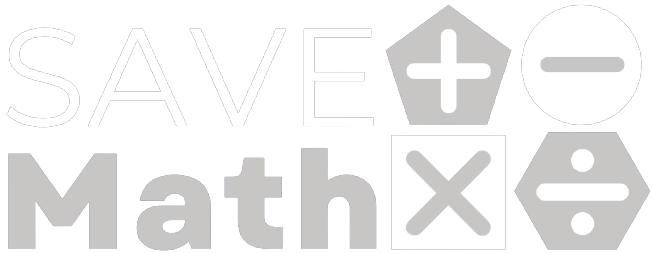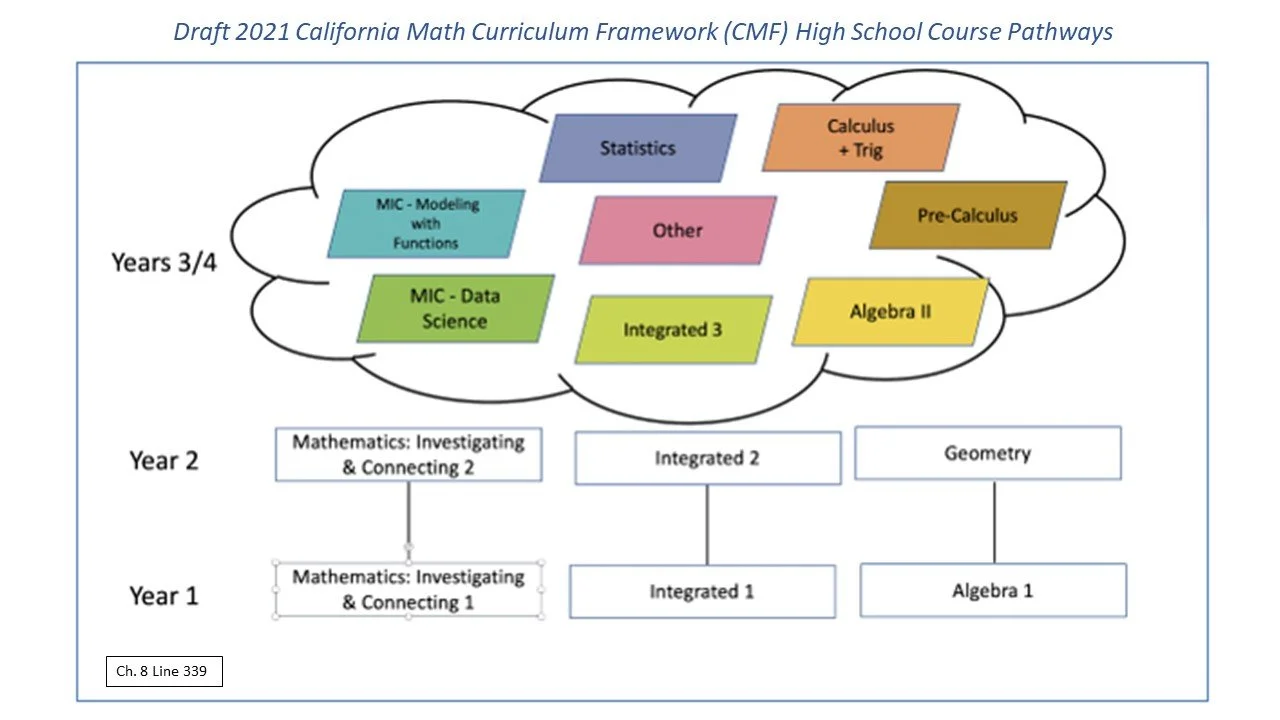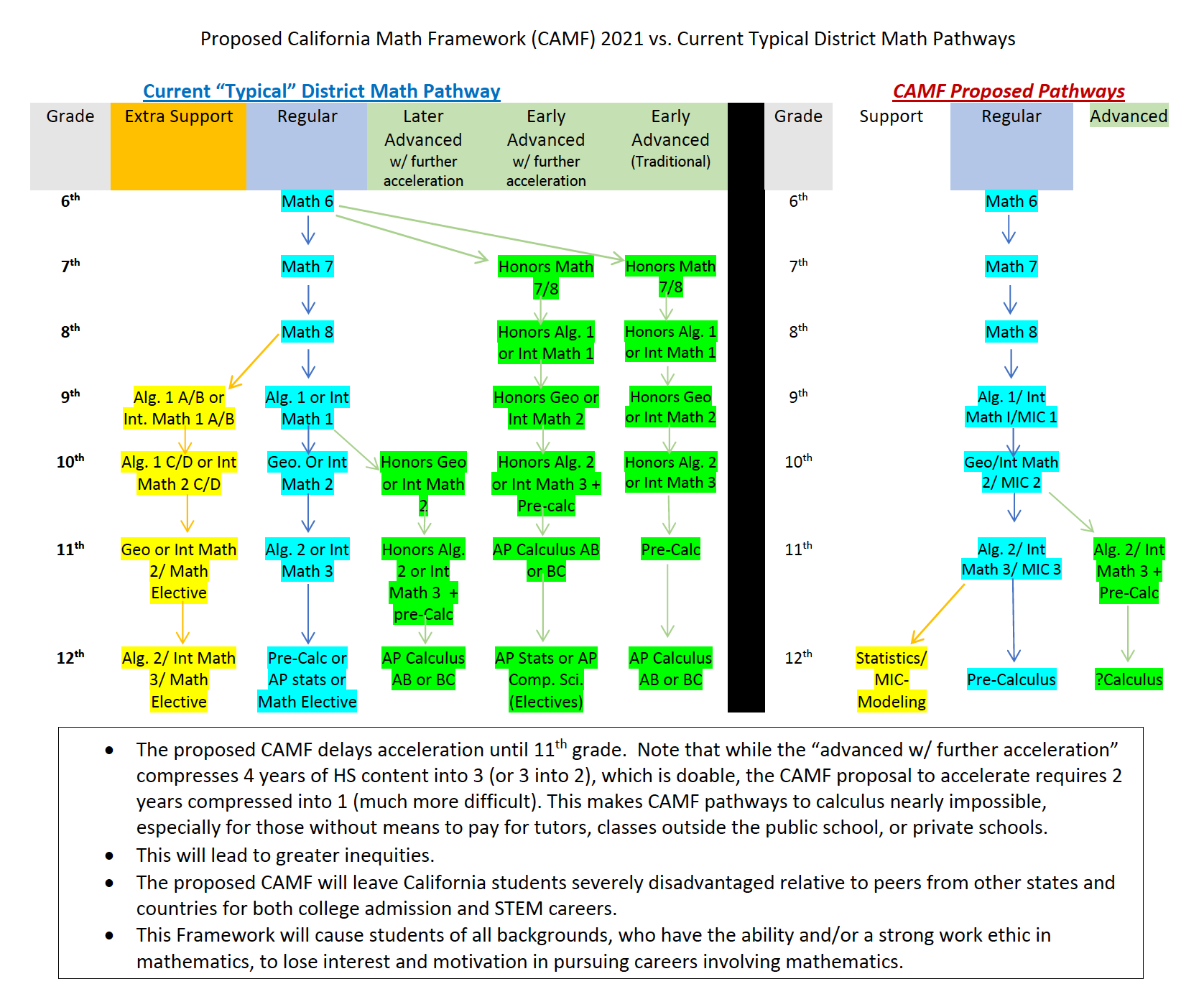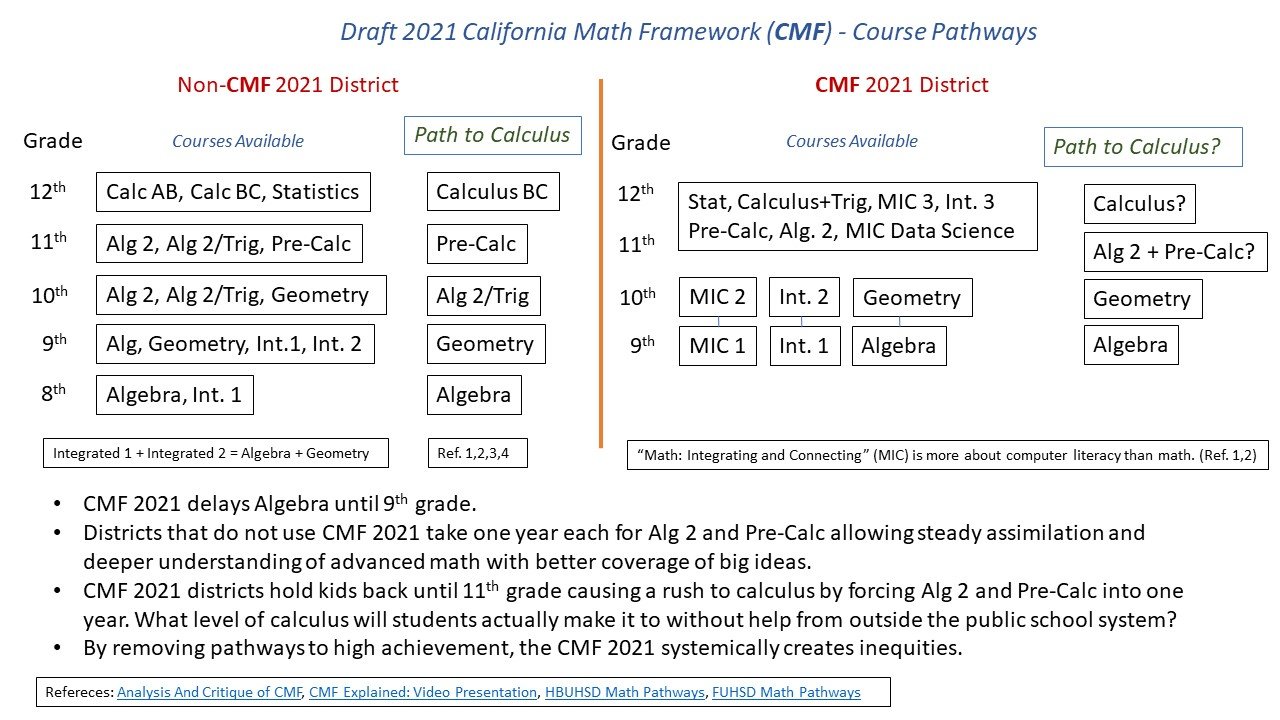
Access to Advanced Classes Is Denied
This commentary was based on the 2021 draft version of the California Mathematics Framework. Updated commentaries, based on the final draft (3/14/2022) of the framework - Second Field Review, are available here.
Item 5 of 6
Executive Summary
Advanced classes are completely removed for all kids until 11th grade. All kids are forced into the same class until then regardless of their level of preparation, motivation, and ability. Acceleration is prohibited. Holding kids back like this prevents them from reaching important mathematical fluency levels by the time they are in 12th grade, thus leaving them unprepared for college majors in Science, Technology, Engineering, and Math (STEM).
Access to Advanced Classes Is Denied
The draft 20211 California Math Framework (CMF) for California Public Schools Kindergarten through Grade Twelve recommends denying access to advanced classes prior to 11th grade. Currently, if a student wishes to take a college level Calculus course in high school 12th grade, they typically follow the first course pathway shown below in Fig. 1 (a):
Fig. 1 a) Current Typical Math Classes and Pathways Available. b) Draft 2021 CMF proposed removal of advanced classes. (Note: The course pathways of Integrated Math 1-3 and Algebra/Geometry/Algebra 2 cover the same material, just in different order, so districts offer only one of these pathways).
It is these classes, Algebra 1 or Integrated Math 1 in 8 th grade, Geometry or Integrated Math 2 in 9 th grade, and Algebra 2 or Integrated Math 3 in 10 th grade, which the draft framework is recommending taking away from students in those grades, as shown by the cross-outs in Fig 1 (b). These are called advanced classes because they are taken in a lower grade than a second pathway that is present in the school system (see Fig. 1). Roughly 1 out of 4 students in the U.S. take Algebra in 8th grade, so this potentially affects a tremendous number of students. Denying access to advanced classes compromises students because “there is also powerful research showing that among academic factors, the strongest predictor of whether a student will earn a bachelor’s degree is the highest level of mathematics taken in high school.”
According to the California Department Of Education “Curriculum frameworks provide guidance to educators, parents, and publishers, to support implementing California content standards”. School boards and school districts look to the framework for guidance in determining course offerings, and County Offices of Education look to the framework for guidance in teacher education and textbook selection. The California Math Framework matters.
When reading the proposed framework, it is of vital importance that the reader look beyond the flowery language of what the draft framework says it is doing, to what it actually is doing. For middle schools grade 6-8 the framework recommends to “organize middle-school mathematics along a common, shared pathway” (Ch. 1, Line 154). This means that instead of offering multiple classes at different levels within a given grade as is often done starting in grades 7 or 8, students of all levels are in the same classroom for math. Students who need more support in math are grouped with students who are ready to advance, along with all students in between. The draft framework is recommending a one-size-fits-all approach to math classes for these grades, with no advanced classes or acceleration available. All students are in the same math class regardless of their preparation, motivation, and ability. This is in contrast to what is often currently offered in most districts as shown in the example from Irvine Unified School District (IUSD) where courses of various levels are offered within a given grade:
Fig. 2 Math course pathways currently available to students in the Irvine Unified School District (IUSD).
For high school grades 9-12, the proposed framework recommends “two to three years of mathematics in a common shared pathway” (Ch. 8 Line 247), “pathways that include multiple years of courses that are taken in common with their peers” (Ch. 8 Line 257), and “high-school coursework, reflecting a common ninth- and tenth-grade experience” (Ch. 8 Line 336). Again, for each grade, it is students of all proficiencies in one class level for math until 11 th grade with no advanced classes available.
The draft framework plans to collapse and remove all differentiated math pathways for grades before 11. This framework suggests the appropriate math placement for all California students for grades before 11, is to be in the same math class/level, regardless of students' ability, interest, or actual math level. The question parents need to be concerned with for their kids in grades 6-10 is how much would a student ready for advancement learn in a one-size-fits all class (also knows as heterogenous classes), where students can be as much as 4 grade levels apart, in comparison to being in an advanced class challenging them at the level they are ready for? This is summarized in the following paper:
“Low-achieving students seem to learn more in heterogeneous math classes, while high and average achieving students suffer achievement losses—and their combined losses outweigh the low achievers’ gains.”
In grades 6-10, one-size-fits-all classes present a difficult situation for teachers as well as students. These students have different needs and require different math tasks and challenges. How does a teacher serve students well in the same math class when their levels differ by 3-4 grade levels? Will students sitting in courses designed for students up to 3-4 grade levels behind lose interest and then lose motivation to excel? These questions can be addressed by looking at the results of a meta-analysis, or a study of studies, results of which are summarized here:
“A review of 380 studies revealed that almost all forms of acceleration result in growth in achievement.”
“When advanced students are presented with curriculum developed for age-peers, they can become bored and unhappy and get turned off from learning.”
The multiple course offerings per grade were shown for IUSD in Fig. 2 and some districts even offer three classes per grade starting in 7 th grade as shown below for Cupertino Union School District (CUSD):
Fig. 3 Cupertino Union School District (CUSD) Math Pathways.
Math pathways are typically implemented in middle school due to students' varying math ability, preparation, interest, and level. What is key is that an Algebra level course can be taken in 8 th grade or earlier. This enables the student to reach the college level course of Calculus by the time they are in 12 th grade by following pathways shown in Fig. 2 and below for Huntington Beach Union High School District (HBUHSD):
Fig. 4 Huntington Beach Union High School District (HBUHSD) Math Pathways.
These figures 2-4 also show that far from offering only a “common, shared pathway” before 11 th grade, multiple pathways are available to the student, and equally important, there are multiple places where the student can change their pathway, as indicated by the lines in the figures going between pathways. In other words, if they were behind and wished to accelerate their learning, they can change pathways, or if they find they are struggling, they can readily change pathways to alter their pacing. Offering multiple pathways gives students options to accelerate if and when they are ready, thus enabling all students.
In stark contrast to this, the high school course sequence recommended by the draft framework is shown below (Ch. 8, line 339):
The draft framework recommends placing Algebra 1 or Integrated 1 in “Year 1” (typically called 9th grade). To be clear, access to the Algebra 1 or Integrated Math 1 class is taken away from 8th graders, access to the Geometry or Integrated Math 2 class is taken away from 9th graders, and access to the Algebra 2 or Integrated Math 3 class is taken away from 10th graders. This is contrary to what is directed in Appendix A to the California Common Core State Standards for Mathematics (CCSSM-A):
“…the Achieve Pathways Group endorses the notion that all students who are ready for rigorous high school mathematics in eighth grade should take such courses (Algebra I or Mathematics I), and that all middle schools should offer this opportunity to their students.”
Though the CCSSM-A says reaching calculus in high school “is a good and worthy goal”, the proposed framework's guidance creates a situation where the content of two year-long courses (Algebra 2 and Pre-Calculus) are forced into one year. Doing this is also contrary to the direction of the CCSSM-A:
“…mathematical concepts are likely to be omitted when trying to squeeze two years of material into one. This is to be avoided, as the standards have been carefully developed to define clear learning progressions through the major mathematical domains.”
What level of Calculus will these students be able to reach when the challenging courses of Algebra 2 and Pre-Calculus, which are year-long courses in the traditional pathway, are compressed into a single year? It is noteworthy that the framework touts as a success and uses as a model district San Francisco Unified School District where they “delayed any students taking advanced classes in mathematics until after tenth grade and moved the algebra course from eighth to ninth grade.” (Ch. 1 Line 472). Of the negative consequences imposed upon students in that district2, one that is particularly noteworthy, is that in order to reach Calculus, students must find classes outside the public school system to accelerate their math instruction. Denying access to advanced classes until 11th grade and then sending them up into the cloud of classes shown in the framework’s course schematic (Fig. 5) does not mean they will successfully cover the content of Algebra 2 and Pre-Calculus in one year and make it to college level Calculus. That pathway has been removed.
The third pathway shown on the left in the Fig. 5, in addition to the Algebra 1/Geometry/Algebra II and Integrated Math 1-3 pathways, is one the proposed framework introduces and calls “Math: Integrating and Connecting/Data Science” (MIC). This series of courses focuses more on data analysis and computer literacy than math content; as such it is not suitable for any student wishing to enter a STEM major or career which rely heavily on math content. This MIC pathway does not lead to the taking of Calculus in high school, nor is it intended to (Ch. 8 Line 122). The irony is that even if a student desires to major in Data Science, a rigorous college math major, even then that student is better served by NOT taking the MIC pathway.
It is very beneficial to take Calculus in high school for a STEM college major for several reasons. Not only do most rigorous science majors start with calculus, such that a student who is unfamiliar with it will be disadvantaged relative to other students who are well versed in Calculus, but a rigorous high school Calculus course allows a student the possibility of placing out of the first year of calculus. This allows the student to move onto the major’s electives, as well as internships and other research options, which bolster resumes and are a powerful way to build connections for future STEM careers as well as be more qualified for graduate school. Furthermore, placing out of required courses for a major means completing the major’s requirements sooner which would make it more likely to graduate on time, a significant cost savings.
The removal of classes and pathways in the draft framework in comparison to a district that does not use this framework is shown schematically in this graphic:
As can be seen, pathways covering students who need extra support all the way to students prepared for acceleration at multiple grades are available. Parents must ask themselves, “which option would they prefer for their child?” The single option proposed by the draft 2021 CMF on the right or the one with multiple options that flex to meet the needs of differing students at different points in their math education.
The framework prioritizes a goal of “inclusion and welcoming” in math (Ch. 1 Line 66), but what could be less inclusive and welcoming than removing pathways that enable STEM careers as the framework does? Clearly, the framework does not seek to include and welcome advanced math students and advanced math achievement, as if it did, its guidance would permit students to be met at their own math level, including taking Algebra 1 in 8th grade. Public schools won't do a better job educating math students by lowering expectations and denying access to advanced math classes. Yet that is exactly what the draft framework proposes to do. Why does this framework have so little confidence in California students?
By taking away advanced classes before 11th grade, students in districts that adopt the proposed framework will be systemically disadvantaged relative to those in districts that do not. Also, within districts that adopt the framework, parents with means and time will be more likely to find ways outside the public school system to accelerate their kids, while kids who rely 100% on the public school for education will lose the opportunity to accelerate and be competitive for scholarships and admissions to elite Universities. Sadly, the latter are typically kids from socio-economically disadvantaged areas. Extracurricular activities play a crucial role in the college admissions process and if students have to spend time outside of school catching up on classes denied them, it is less time for extracurricular activities, an adjustment which also disadvantages them. Thus, the proposed framework systemically creates disparities. The framework states that “equity influences all aspects of this document” (Ch. 1 Line 207), however in its pursuit of equity, it has lost sight of the consequences of taking away math classes and pathways for students, and fails the very group it purports to help.
Summary figure:
*Note: All figures can be expanded to full screen by clicking on them and paging back to return.
NEXT: The Research Doesn’t Add Up
Citations
1. Now renamed as the draft 2022 California Math Framework
2. See The Research Doesn't Add Up section of this website







